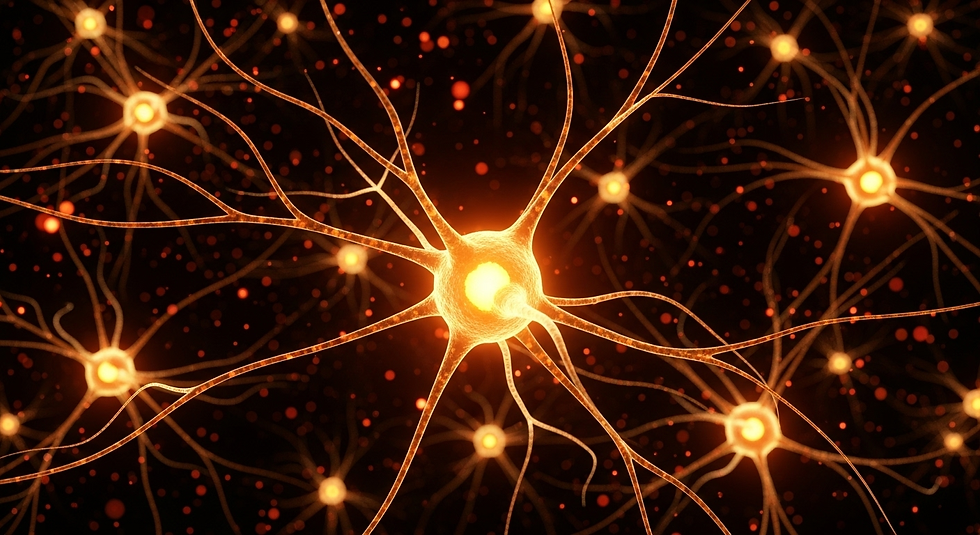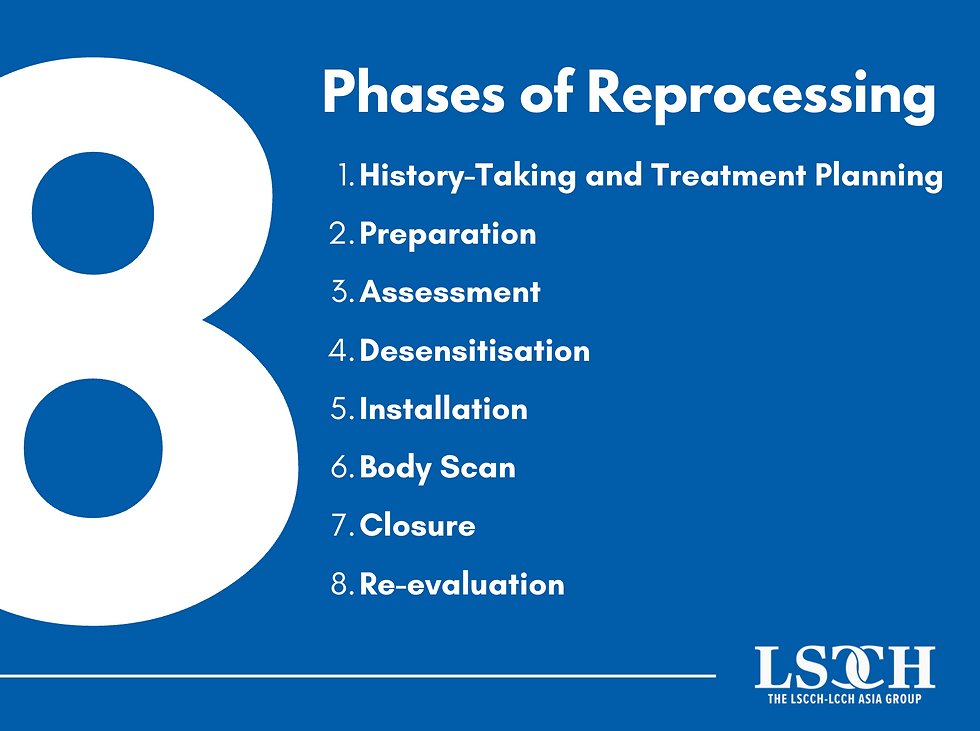What is EMDR? Eye Movement Desensitisation and Reprocessing Explained
- LCCH Asia
- 5 days ago
- 5 min read

Are you seeking effective relief from the lingering impact of past distressing experiences? Eye Movement Desensitisation and Reprocessing (EMDR) is a highly effective and extensively researched evidence-based psychotherapy that helps individuals heal from the symptoms and emotional distress resulting from disturbing life events. Developed by Dr. Francine Shapiro in the late 1980s, EMDR has gained global recognition for its profound impact, notably being endorsed by the World Health Organisation (WHO) for the treatment of psychological trauma.
The Core Idea: Adaptive Information Processing (AIP)

At the heart of EMDR therapy is the Adaptive Information Processing (AIP) model. This model posits that the brain possesses an innate capacity to process and integrate disturbing memories. However, when a traumatic or highly distressing event occurs, this natural processing system can become overwhelmed. As a result, the memory, along with its associated emotions, thoughts, and physical sensations, gets "stuck" or improperly stored in the brain's neural networks.
These "stuck" or maladaptively stored memories can lead to ongoing emotional dysregulation, maladaptive behaviors, and a general sense of dissatisfaction or distress, even long after the original event has passed. They can be easily triggered by current life events, generating feelings of distress or even a sense of being "back in time" (e.g., flashbacks, intrusive thoughts/images, nightmares). EMDR therapy helps to reprocess these memories, allowing them to be stored in a way that is no longer distressing, thus significantly reducing their impact on present-day functioning and promoting lasting emotional healing.
How Does EMDR Work? The Eight Phases of Reprocessing
EMDR therapy is not simply about eye movements; it's a comprehensive, eight-phase approach that systematically addresses past, present, and future aspects of a client's challenges. While bilateral stimulation (often eye movements, but can also be taps or tones) is a hallmark of the therapy, it's integrated within a structured protocol designed to facilitate deep and adaptive memory reprocessing.
The eight phases are:
History-Taking and Treatment Planning: The therapist assesses the client's history, identifies specific disturbing memories or "targets" for EMDR processing, and develops a tailored treatment plan.
Preparation: The client learns essential coping skills and relaxation techniques to effectively manage any emotional distress that may arise during and between sessions.
Assessment: The client identifies the specific disturbing memory, its associated negative belief, a desired positive belief, the intensity of their emotions, and any physical sensations linked to the memory.
Desensitisation: This is where bilateral stimulation (e.g., guided eye movements) is most prominently used. The client focuses on the disturbing memory while engaging in sets of bilateral stimulation. The therapist guides the client through this process, observing their responses as the distress begins to reduce.
Installation: Once the distress associated with the memory has significantly decreased, the client focuses on the desired positive belief (identified in the Assessment phase), strengthening it while continuing bilateral stimulation.
Body Scan: The client mentally scans their body for any residual tension or uncomfortable sensations related to the memory, processing them with bilateral stimulation until they dissipate, ensuring a sense of calm and completion.
Closure: The session is closed responsibly, ensuring the client is stable and equipped with coping strategies, even if the processing of a memory is incomplete.
Re-evaluation: At the beginning of subsequent sessions, the therapist re-evaluates the progress made on previously processed targets and addresses any new related material that may have emerged, ensuring comprehensive trauma resolution.

The 8 Phases of Reprocessing
Bilateral Stimulation: A Key Component for Brain Healing
The bilateral stimulation (BLS) used in EMDR involves rhythmic left-right stimulation of the brain. While eye movements are the most common form, alternative methods include tactile stimulation (e.g., tapping on knees or hands) or auditory stimulation (e.g., tones delivered through headphones). The precise mechanism by which BLS facilitates reprocessing is still being researched, but leading theories suggest it may:
Mimic REM Sleep: The eye movements are thought to mimic the eye movements during Rapid Eye Movement (REM) sleep, a natural phase associated with memory consolidation and emotional processing, thereby activating the brain's innate healing mechanisms.
Reduce Emotionality: It may help to reduce the vividness and emotional charge of distressing memories, making them easier for the brain to process without being overwhelmed.
Enhance Brain Communication: It could facilitate communication and integration between different parts of the brain involved in memory, emotion, and cognitive processing, leading to a more adaptive storage of the memory.

What Conditions Can EMDR Effectively Treat?
While initially developed as a highly effective PTSD treatment, EMDR's applications have expanded significantly. Its effectiveness has been demonstrated in treating a wide range of conditions rooted in adverse life experiences, as highlighted by various professional bodies and extensive clinical research:
The American Psychiatric Association states: "EMDR is an effective treatment for trauma and other adverse life experiences. The therapy has been shown to reduce symptoms of PTSD, depression, and anxiety."
Source: American Psychiatric Association. (2017). Clinical Practice Guideline for the Treatment of Posttraumatic Stress Disorder (PTSD) in Adults. Washington, D.C.: American Psychiatric Association.
The World Health Organisation (WHO) explicitly recommends EMDR for trauma: "EMDR therapy is recommended for children, adolescents and adults with PTSD. This therapy is aimed at reducing the distress associated with traumatic memories. It uses eye movements or other forms of rhythmic left-right stimulation (e.g. hand tapping, auditory tones) to help individuals process distressing memories."
Source: World Health Organization. (2013). Guidelines for the Management of Conditions Specifically Related to Stress. Geneva: WHO.
Beyond PTSD, EMDR therapy is frequently used to address:
Depression and Anxiety Disorders (including generalized anxiety, social anxiety, panic attacks)
Phobias (e.g., social phobia, specific phobias)
Panic Attacks
Grief and Bereavement
Chronic Pain
Addictions
Performance Anxiety (e.g., public speaking, sports performance)
Self-Esteem Issues
Eating Disorders
And other conditions rooted in adverse life experiences, helping individuals achieve emotional regulation and psychological recovery.
Conclusion: A Path to Lasting Healing and Resilience
EMDR therapy is a powerful and efficient psychotherapeutic approach that goes beyond traditional methods to help individuals process and heal from the profound impact of distressing memories. Its structured methodology, combined with bilateral stimulation, actively supports the brain's natural healing capacity, offering a proven path to lasting relief and enhanced well-being.
For therapists, mastering EMDR is a valuable addition to their clinical toolkit, enabling them to address complex conditions more effectively and truly empower their clients towards robust recovery and resilience. By understanding and applying the principles of Adaptive Information Processing, EMDR offers a transformative journey towards freedom from past burdens and a more fulfilling present.
Ready to Master EMDR and Transform Your Practice?
Elevate your therapeutic skills and empower your clients with our comprehensive EMDR training courses. Learn evidence-based techniques to facilitate profound healing and lasting change.
.png)



Comments